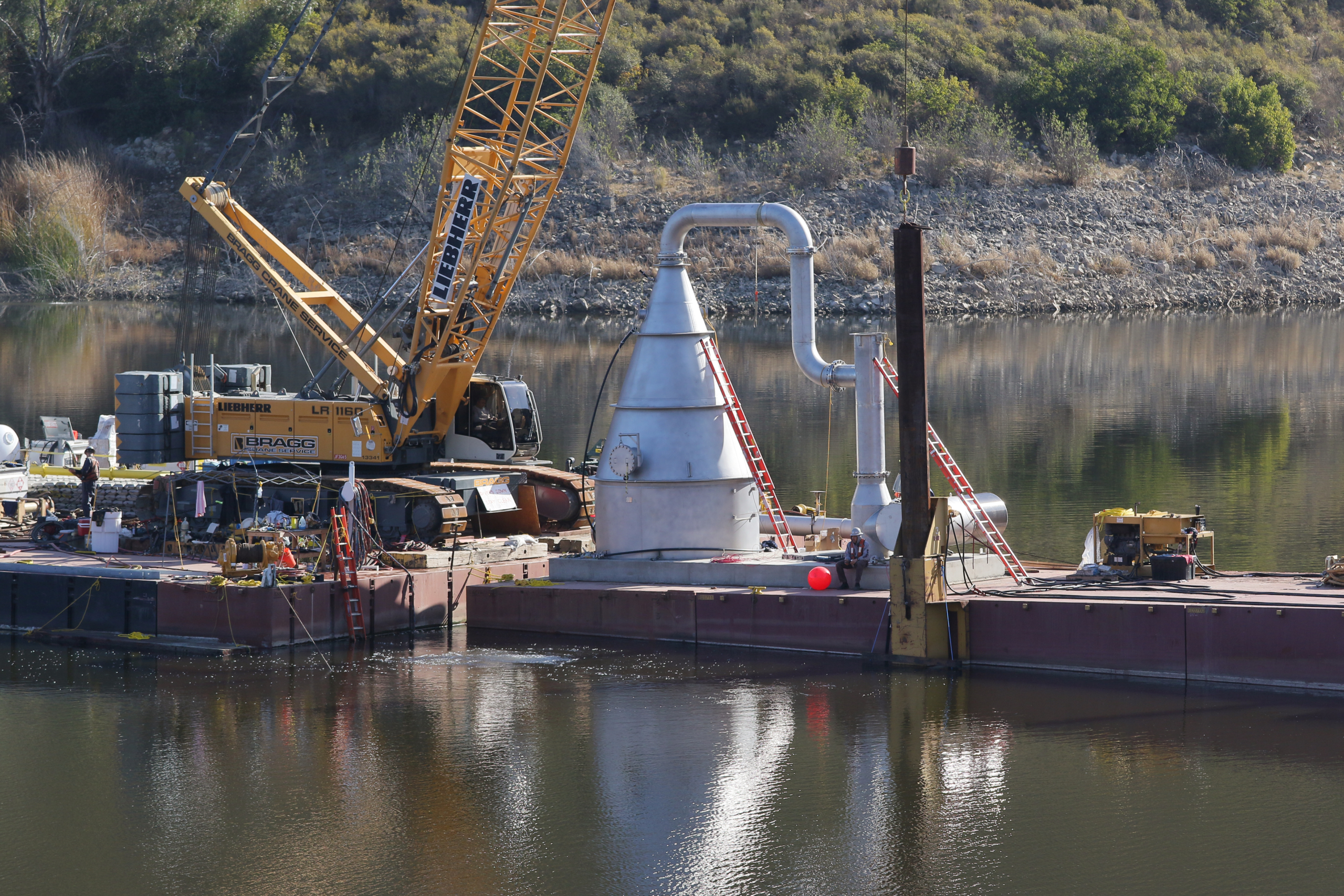Water Companies Close Down Reservoirs to Combat Covid-19 Outbreak
Water companies are asking people to stay at home for the good of their health rather than visit popular sites like reservoirs during the coronavirus outbreak.
Water companies are asking people to stay at home for the good of their health rather than visit popular sites like reservoirs during the coronavirus outbreak.
March rain has left Salt River Project reservoirs as full as they’ve been in a decade. The company is discharging water to make room for the runoff, providing a boost to the underlying aquifers.
February has been amazingly dry in California, if anyone hasn’t noticed. No precipitation at all in February, a dry forecast, about 51% of seasonal Sacramento Valley precipitation (a bit less for the San Joaquin and Tulare basins), and only about half (45-57%) of normal snowpack for this time of year. Unless March is wet, this dry year seems likely to advance the onset of the fire season and threaten forest health this year.
Reservoir levels are still not bad for this time of year. Many are fuller than average, perhaps reflecting some snowpack loss. Some other reservoirs are a bit low. This is inherent in the first year of a drought, low precipitation and snowpack, but mostly ok reservoirs.
Groundwater has recovered somewhat from the previous 2012-2016 drought, better in the north, but less in the state’s more overdraft-prone areas in the San Joaquin and Tulare basins.
Some communities in California just experienced the driest February ever, and there’s around an 80 percent chance the state will enter a full-blown drought this year.
If that happens, it could be the third-driest year in over a century, according to modeling by the Center for Watershed Sciences at UC Davis.
But even though around a quarter of California is undergoing moderate drought conditions experts say it’s too early to panic — they say a second year of drought is where things get dicey.
“The first year of a drought is really mostly a wake-up call,” said Jay Lund, the center’s director. “It will be prudent, if this turns out to be a dry year, for us to prepare for it to be a longer drought.”
Scientists have documented how climate change is sapping the Colorado River, and new research shows the river is so sensitive to warming that it could lose about one-fourth of its flow by 2050 as temperatures continue to climb. Scientists with the U.S. Geological Survey found that the loss of snowpack due to higher temperatures plays a major role in driving the trend of the river’s dwindling flow. They estimated that warmer temperatures were behind about half of the 16% decline in the river’s flow during the stretch of drought years from 2000-2017, a drop that has forced Western states to adopt plans to boost the Colorado’s water-starved reservoirs.
Hundreds of pounds of rainbow trout were biting for participants on Saturday during the sixth annual Kids Fishing Day at Lake Jennings in Lakeside.
The event started in 2015 has been an annual highlight ever since its inception. Kids ages 9 and under fished for free all day Saturday at the Kids Pond, which is a 20-by 20-foot cube within the lake.
Recreation Manager Kira Haley says Lake Jennings was stocked with 2,000 pounds rainbow trout from Wright’s Rainbows in Thatcher, Idaho the week of February 3. Eight hundred pounds went directly into the Kids Pond, which is then attached to the floating accessible fishing dock.
Hundreds of pounds of rainbow trout were biting for participants on Saturday during the sixth annual Kids Fishing Day at Lake Jennings in Lakeside.
The event started in 2015 has been an annual highlight ever since its inception. Kids ages 9 and under fished for free all day Saturday at the Kids Pond, which is a 20-by 20-foot cube within the lake.
Recreation Manager Kira Haley says Lake Jennings was stocked with 2,000 pounds rainbow trout from Wright’s Rainbows in Thatcher, Idaho the week of February 3. Eight hundred pounds went directly into the Kids Pond, which is then attached to the floating accessible fishing dock.
“Kids don’t remember their best day in front of the television, but they remember the first day they caught a fish with a proud parent cheering them on,” said Haley.
Two hundred kids got to catch and take home a trout. Haley says kids as young as two years old participated with a little adult help, including volunteers from the Lakeside Optimist Club, who helped prepare the fishing rods for the kids. Bait choices included nightcrawlers, cheese, white power worms, and mealworms.

Getting your hands a little slimy is part of fun at Kids Fishing Day at Lake Jennings. Photo: Lake Jennings
Operated by the Helix Water District, Lake Jennings stocks 20,000 pounds of trout annually on a biweekly schedule between November and April when water temperatures are cool enough for trout to survive and 10,000 pounds of catfish in the warmer summer months.
In addition, large-mouth bass, red-ear sunfish and bluegill, as well as channel and blue catfish live in Lake Jennings. Sign up for the Lake Jennings Fish Report online to see what fish are biting.
Recreational fishing is the second most popular leisure activity in the U.S., second only to running. While the majority of avid fishermen and women are over 45, approximately 11.25 million youth ages six to 17 participate in fishing in the U.S. annually
The City of San Diego’s Public Utilities Department last week took a major step toward completing an innovative project to improve water quality in Lake Hodges. A newly installed oxygenation system, designed by city engineers, will introduce highly oxygenated water to the bottom of the reservoir to reduce the accumulation of excess nutrients and harmful algae growth.
The increase of nutrients and algae in the water has been caused by human activities in the watershed upstream of the reservoir, including residential and commercial development, agriculture, and land clearing. Degraded water quality can restrict the ability to move water in and out of the reservoir.
“The ‘Speece cone’ is a fairly unique method for adding oxygen to a reservoir – there are only a few of them in the world,” said Jeff Pasek, project manager at the City of San Diego Public Utilities Department. “This project derived from a planning study that was done about five years ago, which identified oxygenation using the ‘Speece cone’ as being the most cost-effective way of addressing the water quality problems in Hodges.”
Last week, the 130,000 pound cone – named after the inventor of the technology, Richard Speece – was lowered eighty feet to the bottom of the reservoir.
The precisely coordinated operation involved lifting the 20-foot tall stainless steel cone with a large crane, while simultaneously driving a barge out from underneath. Once the cone was lowered into the water, divers headed to the bottom of the reservoir to unhook the cone from the crane, check to make sure it settled in the correct spot, and fasten it down.
In order to build a solid foundation underwater, crews excavated approximately 11 feet of silt from the bottom of the reservoir and constructed a concrete base. Before submerging the cone, crews installed and tested a pump that will move water through the cone. A large diffuser pipe was then lowered and connected to the cone by divers. The diffuser will distribute the oxygen-rich water throughout the reservoir.

Now underwater, the cone will distribute oxygen-rich water throughout the reservoir to reduce the accumulation of excess nutrients and prevent harmful algae growth. Photo: Water Authority
Hodges Reservoir is owned and operated by the City of San Diego, and it serves the San Dieguito Water District and the Santa Fe Irrigation District. It is connected to the San Diego County Water Authority’s Olivenhain Reservoir as part of the Emergency & Carryover Storage Project, which is designed to ensure regional water reliability in case of emergencies or if the region is cut off from imported water supplies.
“There are multiple benefits to this project – first and foremost being the water quality improvements for Hodges Reservoir,” said Goldamer Herbon, a senior water resources specialist at the Water Authority. “Ancillary benefits include operational flexibility for regional supply benefits and preventing the accumulation of mercury, which can be harmful to people and wildlife that eat fish from the reservoir.”
The California State Department of Water Resources awarded the City of San Diego a $3.4 million grant funded by the San Diego Integrated Regional Water Management program to complete the oxygenation project, which began in February 2019.
So far, October and November 2019 has been the driest (or almost the driest) beginning of any recorded water year with almost zero precipitation. (The 2020 water year began October 1, 2019 – so you might have missed a New Year’s party already.)
Should we worry about a drought yet?
Water shutoffs aren’t uncommon in the growing cities of Tijuana and Rosarito. But they’re rarely announced beforehand, and they’re often isolated to certain neighborhoods after pipes or pumps fail.
Earlier this month, however, Tijuana officials announced that it was planning wide-ranging shutoffs for the next two months, in an attempt to replenish a vital reservoir that is perilously low.